Wolves are on the prowl again
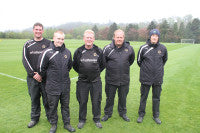
Wolverhampton Wanderers have, like a number of their Midlands rivals, yoyo'ed up and down the leagues in recent times, but the last two seasons saw the string snap spectacularly as consecutive relegations found them playing in Football League Division One for the 2013-14 season.
Die-hard fans may well point to a succession of indifferent choices of manager leading to their demise, but they are in no doubt that the appointment of Welshman Kenny Jackett, in May of last year, was not one of them. His inspirational management style and reliance on youth saw 'The Wolves' gain promotion back to the Championship at the first attempt as Football League One champions, losing only five games all season and amassing a three figure points tally into the bargain.
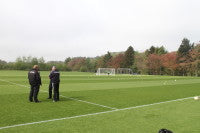
Kenny Jackett is in no doubt that he has the squad to do that next season and says that the quality of the surfaces at both the Molineux stadium and the training ground have played a big part in their success. "The groundstaff are first class, absolutely first class," he comments. "The surface on the first team training pitches and at Molineux can't be bettered anywhere else in the country. That is testament to a lot of hard work that goes on here and I really appreciate it. To have a great surface to play on when we play our games, and also day in day out when we do
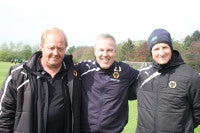
"We all know that, if we work together, we get what we want, which is a good playing surface to train on," continues Kenny. "It is vital to us in trying to produce a good team, and we have had that this year. It has been fantastic to work with and a big part of our success."
Such glowing praise may be rare from a football manager and Wayne has no intention of resting on his laurels. "May is a very busy time for us all," he confesses. "Not only are we dealing with the final games of the season, including corporate hospitality matches, we are also busy arranging our end of season renovations."
My visit coincided with some of the scheduled renovation work being undertaken at the training ground. All the pitches will receive some sort of renovation work to varying degrees during May, the first stage being the academy pitch and rehabilitation areas. Wayne was keen to get these done first so that the players, on their return from their summer break, would have a decent surface to train on. The next pitch to be done will be the first team pitch, built to the same Fibrelastic specification as the stadium pitch. Once the season has finished, the stadium pitch will be renovated.
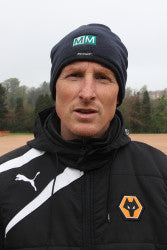
"We have a rehab area over the other side and that's also been fraise mown to expose the top drain sand slits that we put in last year. This will keep them nice and clean and free draining. Both areas were then topdressed and verti-drained to relieve the compaction that had built up over the season. After that, we put a concoction of fertilisers on with a pre-seeder. We went with a new pre-seeder this year, with a slightly higher phosphorus content. The aim is to build a big root mass up to the existing one that is in there."
"We will then go with our normal base feed, just to keep us ticking over until the new seed comes through. After that, we will go four ways with the disc seeder. Then, the fifth pass will be with the dimple seeder, just to fill in the disc seeder, so we are not left with cubing. The dimple seeder fills in the cubes lovely. We should get a very good take and, from there on in, we should have a very good surface instantly for the first team to come back in and train on."
"After that, the next two pitches at the training ground will get what we would call a normal renovation nowadays, where the top comes off, all the foliage comes off, all the crown of the plant comes away and we are left with bare material. We will then introduce fresh material, whether that be a sand rootzone or Fibrelastic. That will be wheeled in and stone raked, with just a normal base feed added in. Then we will go with a full rye grass mix on all pitches."
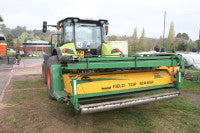
"Once we have completed the training ground renovations, we will go to Molineux where, this year, we are going to try and do something slightly different. We are going to go with a fraise mow and then re-jig our spraying and nutrient programme, by applying more to the profile rather than the leaf. This should alleviate any black layer or problems caused by the lack of aeration in keeping with good practice."
"The Molineux pitch is Fibrelastic as well, although it is a slightly different construction to the first team training ground pitch. Molineux is a full sand construction; almost what you might term a USGA specification - in the loosest term, as there are many different ideas of USGA specification - but it is basically built on a gravel raft on a perched water table. By comparison, the first team training pitch is Fibrelastic in the top 100mm which is sand ameliorated underneath with gravel banding rather than sand banding, so it is a slightly different make up, but performs just as well."
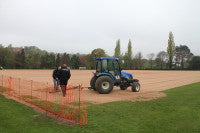
"It will probably take the best part of two weeks for Derrick to do the whole training ground. The first team training pitch and the youth pitch take a bit longer as they have to be power harrowed and refreshed so, just to consolidate, wheel back and get prepped ready for seeding does take a wee bit longer."
"When you get a good contractor like Derrick, who has been doing this work for a number of years - about nine I think, then we know we won't have any problems. This, though, will be the first time he has done our first team training pitch, but he is a very experienced guy with a very experienced team working under him and, with our input, we can help each other along, so we should have as good a finish as we would expect to have."
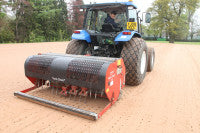
"In Kenny Jackett, we also have a manager who is very pitch friendly. Both he and his assistant, Joe Gallen, very much want to work with us rather than against us, which is a breath of fresh air. You can see the condition the first team training pitch is in at this time of year and most people would be happy with that for the whole season. That is a pitch that is trained on heavily throughout the year, but it isn't just the Fibrelastic that has helped keep it that way, it is the good practices as well from ourselves and also a manager who is very keen not to abuse it. We always say use it, don't abuse it. We want to get the best out of it for the longevity of the season. We also hope that, because he has had that quality to train on this year, it has helped Wolves maintain that level of consistency over the season to win the league. We hope it has had a small part to play."
"Fibrelastic came along a few years ago and Bristol City and Newcastle were the first to install it in 2007. The beauty of it is that, although it is a reinforced material, unlike Desso, which gets a little too firm in my opinion, it comprises 80% by volume sand and 20% by volume organic matter, reinforced with both Polypropylene and Elastane fibres, so it has more give, but you maintain the stability. It is the next generation up from the Fibresand pitch."
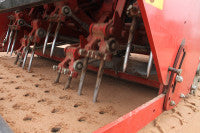
"Obviously, Molineux is a bit different as it has shaded areas, so we have to manage it differently as these shaded areas hold on to the moisture, so we don't need as much in there. We take moisture content readings prior to and leading up to games so we know where we are, and can level up the moisture content so there is no more than 5-10% difference in moisture."
"Whilst we occasionally take Clegg hammer readings over the season, we know ourselves, just by walking on the surface, when it is getting too firm. So we will just aerate it with 13mm solid tines on the Toro ProCore and that seems to alleviate any problems from there on in. Then we will give it a couple of weeks to breathe and roll it back down again. Then the pitch will be ready to go again and receive a bit more moisture."
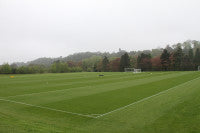
"I think the first thing is to absolutely do the basics right. Let's start by having a clean mower and a blade that is sharp and set right because, if you haven't, then you are going to get ragged edges and, therefore, poor nutrient uptake, poor colour and disease outbreaks. So let's start with a clean mower."
"And let's not constantly be on the pitch working at it all the time when it doesn't need it. The pitch needs a rest, so fix it as quickly as you can after a match. I can't put enough stress on divoting the pitch to maintain and improve surface levels. And repair scars; let's get the pitch back into order quickly."
"Keep nutrient levels up as much as you can afford to. If you can't afford the levels that we can, then try and choose a slow release that can maybe see you over a longer period of time - a nice base feed topped up with other feeds. Keep moisture levels correct. Basically, just stick to good practices and do not over abuse the pitch."



